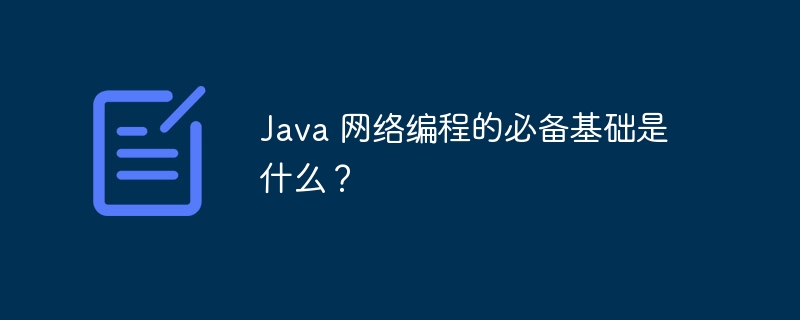
Necessary basics of Java network programming: Master network basics: IP address, TCP/UDP protocol, HTTP and Socket. Master Java I/O: input/output streams and byte streams. Familiar with NIO/NIO.2: non-blocking I/O, improving application performance. Master the Java standard networking APIs: Socket, ServerSocket, URL, and URLConnection. Understand network security concepts: TLS/SSL encryption, SSL, and digital certificates.

The essential foundation of Java network programming
Understand the basics of the network
Master the basics of the network Concepts such as IP address, TCP/UDP protocol, HTTP, HTTPS and Socket, etc.
Master Java I/O
Understand the input/output stream and byte stream in Java, including InputStream, OutputStream, Reader and Writer etc.
Using NIO/NIO.2
Get familiar with Non-blocking I/O (NIO) and Non-blocking I/O 2 (NIO.2) and learn how they can improve network applications performance.
Proficient in using Java standard network API
Master the classes in the java.net package, including Socket, ServerSocket, URL, and URLConnection, etc., are used to handle network sockets and URL connections.
Understand network security concepts
Master the basics of network security, including TLS/SSL encryption, Secure Socket Layer (SSL), and digital certificates.
Practical case: Create a simple HTTP server using Java
import java.io.IOException;
import java.net.ServerSocket;
import java.net.Socket;
public class HttpServer {
public static void main(String[] args) throws IOException {
// 创建一个服务器套接字,侦听端口 8080
ServerSocket serverSocket = new ServerSocket(8080);
while (true) {
// 接受一个客户端连接(此方法阻塞)
Socket clientSocket = serverSocket.accept();
// 创建一个输入流以从客户端读取数据
BufferedReader in = new BufferedReader(new InputStreamReader(clientSocket.getInputStream()));
// 创建一个输出流以向客户端发送数据
PrintWriter out = new PrintWriter(clientSocket.getOutputStream());
// 逐行读取客户端请求
String request = "";
while ((request = in.readLine()) != null) {
// 解析 HTTP 请求并提取 URI
String uri = request.split(" ")[1];
// 根据 URI 发送响应
if ("/".equals(uri)) {
out.println("HTTP/1.1 200 OK\r\nContent-Type: text/html\r\n\r\n<h1>Hello World!</h1>");
} else {
out.println("HTTP/1.1 404 Not Found\r\nContent-Type: text/html\r\n\r\n<h1>404 Not Found</h1>");
}
}
// 刷新输出流以将响应发送到客户端
out.flush();
// 关闭客户端套接字
clientSocket.close();
}
}
}Conclusion
By mastering these basic knowledge, you You'll have the skills needed to build robust, efficient Java web applications. Through continued practice and exploration, you will broaden your knowledge and become a proficient Java network programmer.
The above is the detailed content of What are the necessary foundations for Java network programming?. For more information, please follow other related articles on the PHP Chinese website!
